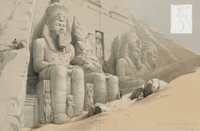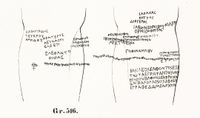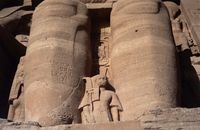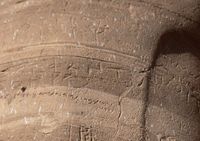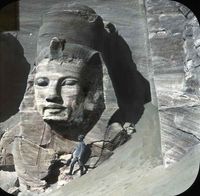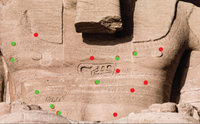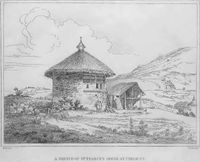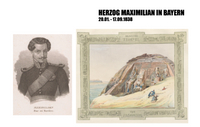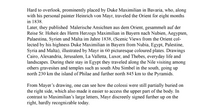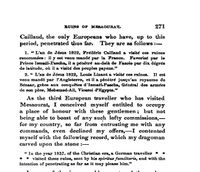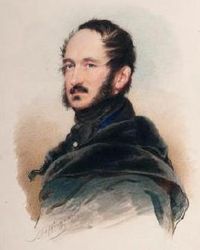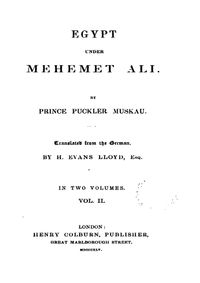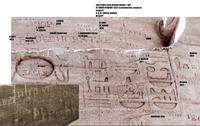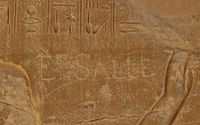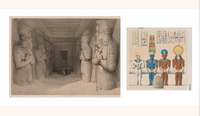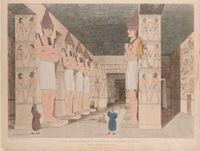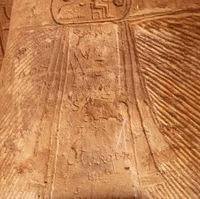ABU SIMBEL
Abu Simble by David Roberts
Probably from William George Browne, who was an English explorer traveling to Egypt, Darfur and Syria in the years 1791-1798. Photo by Frank Mason Good, ca. 1856.
Greek Soldiers
The cultural and historical importance of inscriptions for linguists and historians is illustrated by the examples of the Ionian writing at Abu Simbel- helping as a source for the reconstruction of historical events. For linguists the ionian graffiti provide insights into the passage of mercenaries from different backgrounds at Abu Simbel. In addition this graffiti proves that the ancient Greek alphabet was derived from the Phoenician script. Historians, on the other hand, can use the graffiti as a source in order to reconstruct the route of travellers along the Nile.
Written in archaic Ionic letters by various hands from left to right,
Milne, J. Grafton: Greek and Roman Tourists in Egypt, The Journal of Egyptian Archaeology, Vol. 3 1916.
Ionian inscriptions right under the knees of the second statue. Photo 8mm.media
German Egyptologist Johannes Dümichen (1833-1894) researching ancient inscriptions in the 1860s along the Nile observed on how the statues at Abu Simbel were full of graffiti:
"On the outside and inside of the entrance, on arms and legs, on chest and face of the colossi, everywhere where only a hand could reach, tourists from all over the world have relentlessly scratched and smeared their names. This desecration perpetrated by the educated travellers of the 19th century on almost all accessible Egyptian monuments has reached here, at the temple of Abu Simbel, an in malam partem in fact admirable height."
malam partem -unfavourable
I should like to see them subjected to a merciless bastinado, on the same part of their own bodies. Certainly, to have one of the statues seated on their breasts as a nightmare, every night of their lives, would not be too much punishment for such a desecration."
(Taylor, James Bayard: Journey to Central Africa, New York 1854)
3rd colossus
(3rd colossus, more updates on names will follow. Photo 8mm.media)
Nathaniel Pearce (1779-1820)
Nathaniel Pearce, an English sailor, adventurer and traveller, spent 14 years in Egypt and Ethiopia traveling several times down the Nile, participating in two of Consul Salt's Expeditions. Pearce had travelled previously to India, had been in captivity, tried to escape several times, killed someone while trying to escape, and eventually made it on a Boat where he met the British consul in Cairo Henry Salt. More will follow, as Pearce had a very adventurous life, of which also Henry Salt reports of, in his own biography.
Keersmaeker documented nine graffiti along the Nile, done by Pearce: Dendera, Medinet Habu, Kalabsha, Beit el-Wali Elkab Rock Tombs, Medinet Habu, Philae, Qertassi and Deir el-Medina.
Fürst Hermann von Pückler-Muskau (1785-1871)
(Abu Simbel, torso, 3rd colossus)
Prince Hermann Ludwig Heinrich von Pückler-Muskau, commonly known as Prince Pückler, was a German nobleman, landscape designer, and writer. Considered one of the finest examples of European landscape architecture during the 19th century, Muskauer Park (combing elements of English and Romantic garden design) located on the border between Germany and Poland. In addition to his contributions to landscape design, Pückler authored several books, including travel narratives and essays on various topics.
Between 1834 and 1840, Pückler-Muskau traveled from Muskau through France to North Africa and explored the Mediterranean region, including Malta, Greece, Crete, Syria, Asia Minor, and the Nile, In Egypt in 1837, travelling down the Nile up to Elkueh on the Dinder, which is approximately 200 km south of Khartoum.
Back home he published his experiences of the six-year expedition in twenty publications highly respected works, with new drawings of maps Pückler published under the pseudonym in Briefe eines Verstorbenen (Letters of a Deceased) and Egypt under Mehemet Ali.
First complaining about Belzoni and the others, it was Pückler himself leaving graffiti of his name on several temple sites along the Nile.
In Egypt under Mehemet Ali he admits, while visiting Mesaourat, believing he was only the third European to have visited the site, finding only 2 french graffiti left by previous travellers:
"It gave me greater pleasure to discover among these reminiscences, two long modern inscriptions by Messrs. L i n a n t and Caillaud, the only Europeans who have, up to this period, penetrated thus far. They are as follows :
1. « L'an de Jésus 1822, Frédéric Caillaud a visité ces ruines renommées: il y est venu mandé par la France. Favorisé par le Prince Ismaël-Pascha, i la pénétré au-delàde l'azole par dix dégréa de latitude, où il a visité des peuples payens."
2. « L'an de Jésus 1822, Louis Linant a visité ces raines. Il est venu mandé par l'Angleterre, et il a pénétré jusqu'au royaume de Sénaar, grâce aux conquêtes d ' I s m a ë lPascha, Général des armées de son père, Mehemed-Ali, Viceroi d'Egypte."
"As the third European traveller who has visited Mesaourat, I conceived myself entitled to occupy a place of honor with these gentlemen; but not being able to boast of any such lofty commissions,- for my country, so far from entrusting me with any commands, even declined my offers, I contented myself with the following record, which my dragoman carved upon the stone:
"Im Jahre 1837 unserer christlichen Zeitrechnung hat ein deutscher Reisender ... diese Ruinen besucht, gesandt durch seinen spiritus familiaris, und mit der Absicht so weit vorzudringen, als es ihm Vergnügen machen wird."
"It is most revolting to see how shamelessly modern visitors have degraded the sculptures, by the most indelicate additions, carefully drawn with charcoal, and even with black paint : truly the lowest of the natives would not be guilty of such vulgarity; and it is disgraceful to think that men who have come so far from civilised Europe should leave behind such traces of their visit."
Main entrance, left side, 2nd colossus
Battiscombe George "Jack" Gunn, (1883 –1950) was an English Egyptologist and philologist, translating inscriptions for many important excavations and sites, including Fayum, Saqqara, Amarna, Giza and Luxor.
Eusèbe De Salle 1796-1873, doctor, scientist, arabic professor, translating in 1821 the literary works of Lord Byron, working as a translator in 1830 in Algier, later traveling through Egypt. A few years later he published his travel experience in Pérégrinations en Orient ou voyage pittoresque, Historique et Politique en Egypte, Nubie, Syrie, Turquie, Grèce pendant les années 1837-38- 39, 2 vol., Paris 1840.
De Salle left his name on several sites, which annoyed someone, as the name is crossed out and written over in capital letters "NO". Keersmaeker found the the name, besides Abu Simbel, at Kalabsha, Beit el-Wali, Elkab Rock Tombs and Qurna, Deir el-Medina.
INSIDE THE GREAT TEMPLE
Above: Inside the Great Temple, by David Roberts, drawings from Lepsius.
Photographs reveal graffiti on the colossi arms. Photo by Diego Delso, 2022 (delso.photo)
